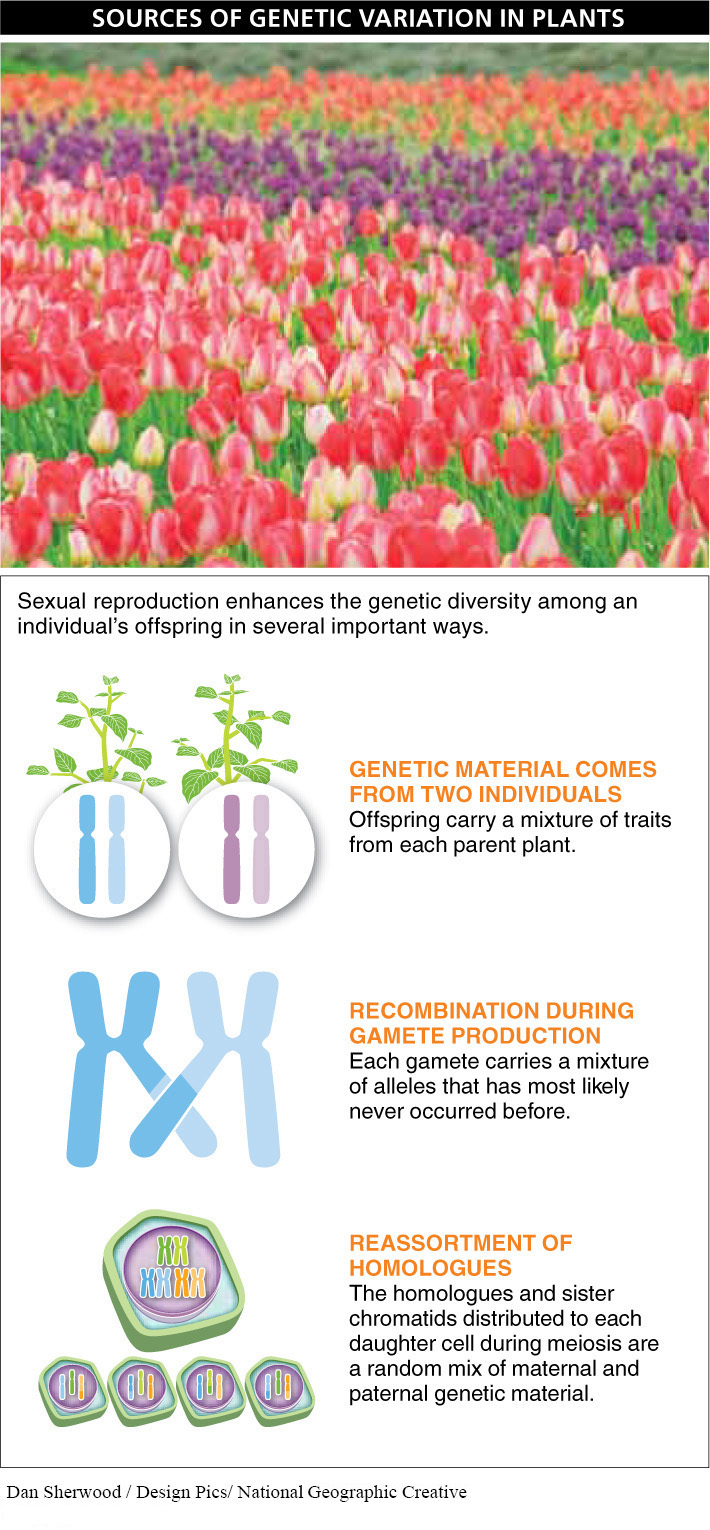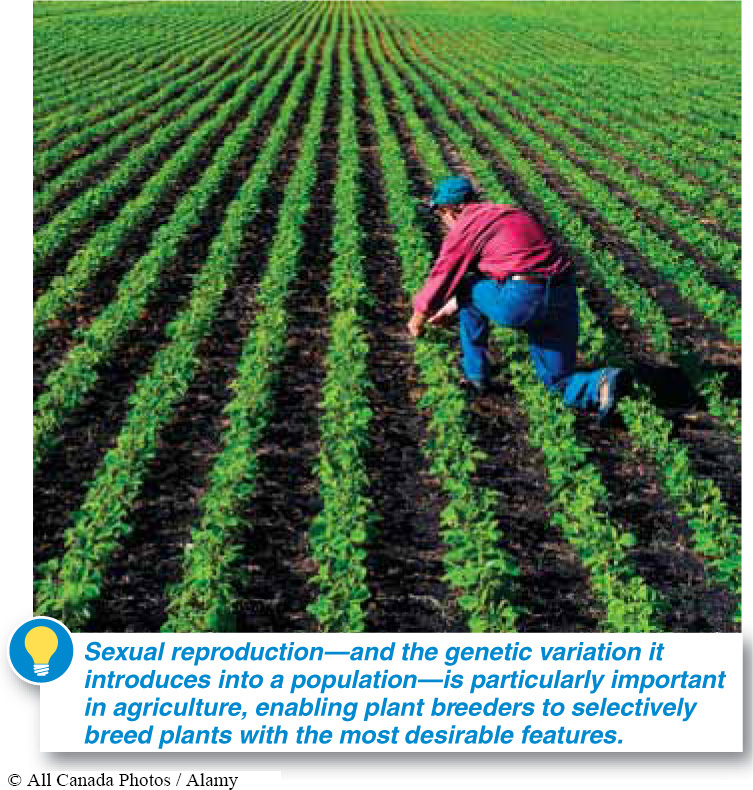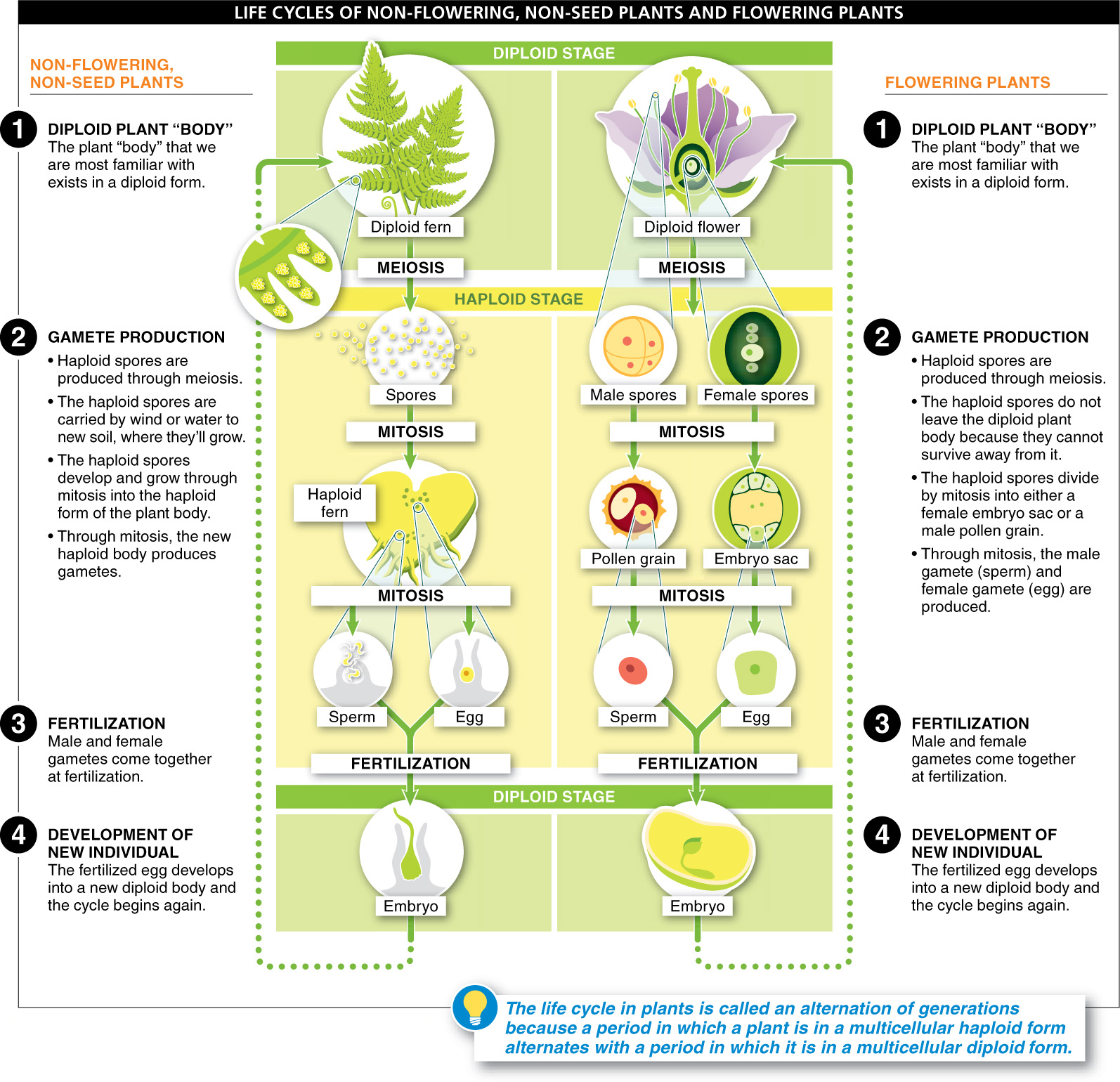18.3: Plants can reproduce sexually, even without moving.
For all its efficiency and advantages, asexual reproduction just doesn’t measure up to sexual reproduction in plants. In fact, despite the difficulties associated with being anchored in one place, the ability of plants to reproduce sexually is at the heart of their evolutionary success. Because sexually reproducing populations generate large amounts of genetic diversity, they can keep up with changing conditions better than asexually reproducing plants by adapting to new environments.
Sexual reproduction, whether in plants or in animals, enhances the genetic diversity among an individual’s offspring in several important ways (FIGURE 18-5). First, because the genetic material comes from two distinct individuals, the offspring isn’t a duplicate of either parent but, instead, carries a mixture of traits from each. This outcome is analogous to having two people try to solve a group of problems together versus one person going it alone; the pair will probably arrive at better solutions. Second, as we saw in Chapter 6, for each individual, in the process of producing sperm or eggs, recombination during crossing over causes each gamete to carry a mixture of alleles from that individual’s mother and father—
Sexual reproduction (and the resulting genetic variation in a population) is crucial in agriculture, because plant breeders can selectively breed plants for the most sought-


In plants and animals, the process of sexual reproduction has some common steps. Meiosis is an essential part of the process by which individuals produce gametes. The gametes come together to produce a fertilized egg, which develops and grows by mitosis. Finally, the fertilized egg is transported to a place where it can survive and grow. These steps occur in all organisms that reproduce sexually. Sexual reproduction in animals and in plants always involves meiosis and fertilization, and because these processes are repeated in every generation, they make up what is called a life cycle.
730
Because plants cannot move, the male gamete must reach the female gamete without the parent plant uprooting itself to find an individual to mate with. Thus, the plant life cycle includes steps that increase a plant’s ability to safely deliver the male gamete to the female gamete. We trace the life cycles of non-
Life Cycle of Non-
- 1. One form of the plant “body” that we see is diploid (but there are also multicellular haploid forms).
- 2. Production of gametes:
- a. Through meiosis, the diploid body, called a sporophyte, produces haploid cells called spores. Although spores are haploid, they are not gametes.
- b. The haploid spores are carried by wind or water to new soil, where they germinate—that is, after a period of dormancy, they begin to grow.
- c. Through mitosis, the haploid spores develop and grow into the second form of the plant “body” that we see: a new, haploid plant, called a gametophyte.
- d. Through mitosis, the new haploid body—
the gametophyte— produces gametes.
- 3. Fertilization: Male and female gametes come together at fertilization.
- 4. The fertilized egg develops and grows, by mitosis, into a new diploid body, and the cycle begins again.

731
Note that in non-
732
Life Cycle of Flowering Plants
- 1. The plant “body” that we see is diploid.
- 2. Production of gametes:
- a. Through meiosis, the diploid body—
the sporophyte— produces haploid spores. Although they are haploid, spores are not gametes. - b. The haploid spores do not leave the diploid plant body.
- c. Within a flower on the plant body, the spores divide by mitosis to form a gametophyte that is either a haploid female embryo sac or a haploid male pollen grain.
- d. Through mitosis, the haploid embryo sac produces a haploid female gamete (an egg), and the haploid pollen grain produces a haploid male gamete (a sperm).
- a. Through meiosis, the diploid body—
- 3. Fertilization: Male and female gametes come together at fertilization. Following fertilization, a seed develops from the ovule (see Section 18-
11.) - 4. The fertilized egg (which typically has been moved away from the plant on which fertilization occurred—
see Section 18- 12 for a discussion of dispersal methods) develops and grows, by mitosis, into a new diploid body, and the cycle repeats.
The life cycle in plants is called an alternation of generations, because a period in which a plant is in a multicellular haploid form alternates with a period in which it is in a multicellular diploid form. If the same thing happened in humans, it would be the stuff of science fiction: the cells in our testes or ovaries, instead of producing sperm or eggs, would produce a special creature that would leave our bodies, live elsewhere on its own for a while, and then produce sperm or eggs. The eggs and sperm from one individual creature would then find some way to come together with sperm or eggs from another such creature, undergo fertilization, and produce babies.
For the remainder of this chapter, we focus on the sexual reproduction of flowering plants (the angiosperms), because they are the predominant group of plants on earth. All angiosperms produce flowers, the structures in which the gametes develop and in which much of the reproductive activity takes place. We begin by exploring the role of flowers in helping plants solve the problem of how to bring male gametes to female gametes when plants are rooted in the ground.
TAKE-HOME MESSAGE 18.3
Many plants can benefit from producing genetically varied offspring through sexual reproduction, with the flower as the chief structure for sexual reproduction.
If plants produce gametes by mitosis, why is meiosis necessary?
733